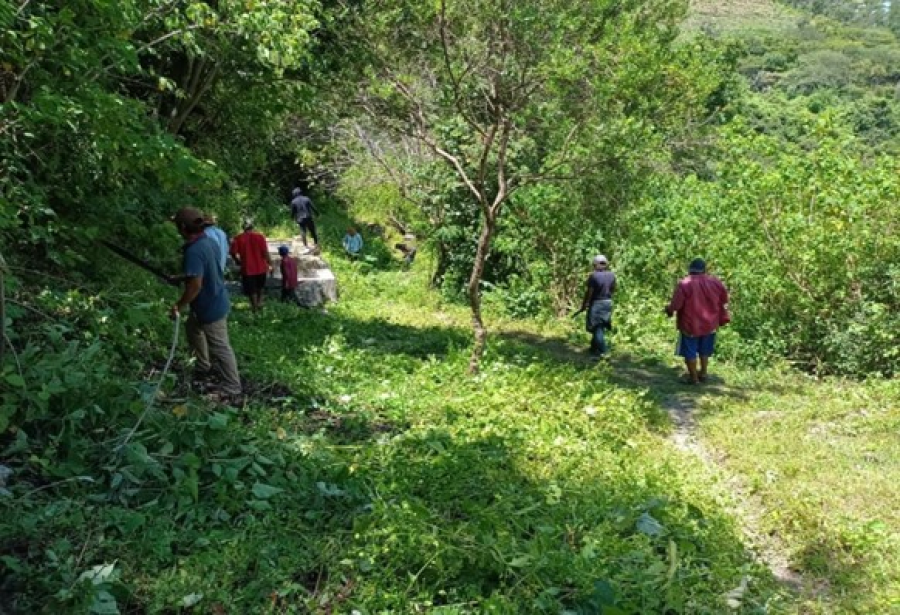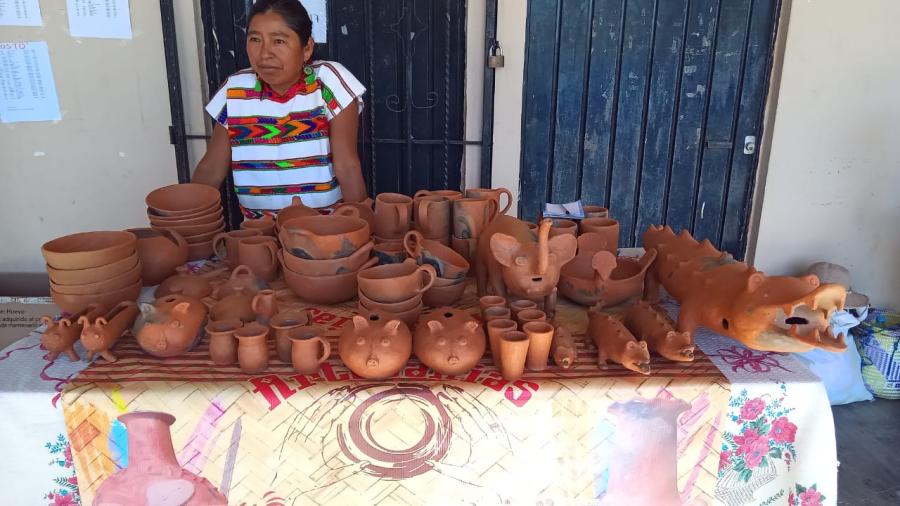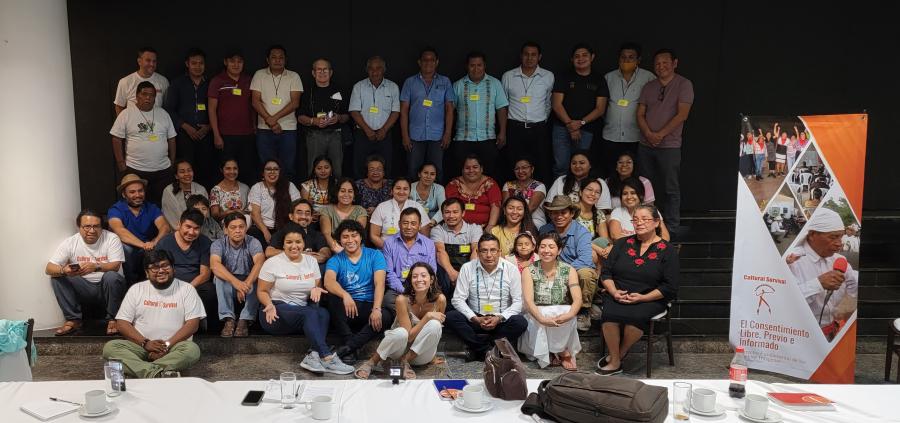The political experiences of indigenous migrants who seek to influence, from the United States, political processes at varying levels from local to national presents a challenge for the emerging indigenous movement in Mexico. How can the demands of indigenous migrants who are scattered beyond their traditional territory be incorporated into the list of causes taken up by the national indigenous movement? How can key concepts of the indigenous movement, such as indigenous autonomy, territorial rights, recognition of indigenous communities' internal normative systems, be reformulated in such a way that they adjust to the realities of communities with high migration rates, like the Mixtecos? Before an attempt to offer an approach to these problems, we must detail the current context of indigenous communities with high rates of migration, such as the Mixtecos from Oaxaca, Mexico.
Much has changed within indigenous communities during the last two decades. A particularly dramatic change for the Mixtec communities of Oaxaca was their entrance into the process of migration to northern Mexico and the US, which reached massive dimensions in the mid-1980s. The economic restructuring of the country and social welfare cost-cutting seen during this same period had a particularly intense impact in the Mexican countryside. Increases in unemployment and the lowering of already paltry wages led thousands of indigenous people in the Mexican countryside, such as the Mixtecos and Zapotecos of Oaxaca, the Totonacas of Veracruz, the Nahuas of Guerrero and Purépechas in Michoacán, to join the migratory flow towards the US. Recent studies have shown that migrant indigenous workers such as the Mixtecos account for between five and seven percent of the agricultural work force in California. Additionally, a considerable number of Zapotecos, estimated to be between 15,000 and 20,000, can be found in the Los Angeles area and San Diego County.
This migration is having notable effects on the debate surrounding indigenous rights in Mexico. Indigenous migrants, far from becoming passive victims of the discriminatory and exploitative conditions they face on both sides of the Mexico-US border, have responded in a highly creative way, building cross-border political organizations that make collective action possible in both their communities of origin and those established along their migratory circuit. The community-based organizations created by these indigenous migrants also provide us with a new vocabulary in referring to the indigenous communities that find themselves dispersed to different sites in the north of Mexico and the US, yet which remain united due to complex social networks. Information, money and merchandise flow through these networks, securing the ties between families and communities across a distance of more than 2000 miles and various geographical and political borders.
Cross-Border Projects
The majority of these new migrants come form indigenous regions of states that have not been traditionally characterized by the displacement of workers to the US (such as Oaxaca, Puebla and Guerrero). Consequently, the presence of vibrant bi-national organizational projects in precisely these populations of new migrants is noteworthy. It should also be noted that ethnicity emerges here for the first time as a mechanism of organizational identity, bolstered by ethnic movements throughout Latin America and within Mexico itself. The binational community-based organizations constructed by these new migrants differ significantly from the less politicized, more informal organizations previously developed by Mestizo migrants from traditional sources of migrant labor in west-central Mexico (Jalisco, Michoacán, Guanajuato and Zacatecas). These organizations' proposals include the possibility of innovative projects that confront the problem from the perspective of the sending communities and offer development alternatives for international policy in order to face the new crisis in Mexico-US relations driven by immigration issues. Likewise, in contrast to the exclusive focus on financing of public works seen in hometown associations, these new cross-border indigenous organizations focus principally on social and political change both in their communities of origin in Oaxaca and the communities where they reside in the United States.
The novelty of the cross-border indigenous organizations is the presence of a more integrated participation on the part of migrants in their communities of origin. This means that migrants are not distanced from the political processes that develop in their communities of origin, but rather are active participants. Consequently, the economic development projects promoted by their organizations arise from a process of deliberation in which both those who leave and those who stay participate.
California -- Oaxaca
The migration of indigenous Oaxacan workers to northern Mexico, especially to the Culiacan Valley in Sinaloa, the San Quintín Valley in North Baja California and the US (principally California, Oregon, Washington and Florida), is a relatively recent phenomenon. Nevertheless, it has reached significant levels, especially since the beginning of the 1980s. A census carried out in 1991 by the California Institute for Rural Studies found that indigenous Mixtec migrants accounted for five- to-seven percent of the work force in the state's agricultural secton This means that during the harvest, the period when the highest amount of labor is required, almost 50,000 Mixtecos were employed in California. Although this is a conservative figure, it gives us an idea of the enormous number of Mixtecos entering the migratory network that extends across various states in the US and the north of Mexico. At the same time, we should note that this census focused only on agricultural workers and did not collect data on Mixtecos in urban centers, such as San Diego, Los Angeles and San Francisco. The thousands of Zapotecos who are principally concentrated in the Los Angeles area and San Diego North County were also not taken into consideration.
The census documented members of 203 communities in Oaxaca (including Zapoteco, Chinateco, Triqui and Mixteco communities), pertaining to 81 municipalities. A total of 22 districts of the 30 that exist in Oaxaca were represented in the census. This data suggests that Oaxacan migration originates in many parts of the state, but it tends to be concentrated in certain subregions. The districts most represented in the census of Oaxacan Village Networks in California's Agriculture were Juxtlahuaca, Silacayoapan, Tlaxiaco and Huajuapan de Leon -- all in the Lower Mixteca Region.
At first glance, it seems that the wide geographic dispersion of indigenous workers' migration would be a fatal blow to the communities immersed in this process of integration between the US and Mexico. Nevertheless, indigenous communities have responded creatively to the challenge of maintaining the social and cultural web that makes the community viable across geographic distances. Through the migration process, indigenous peoples have strengthened their ethnic identity, which has made it possible for them to organize and maintain close ties with their communities of origin. This has made direct participation in the issues most relevant to their communities possible, regardless of where they are physically located. In the case of the Mixtecos, migrants continue not only to be taken into consideration in important decisions affecting the community in general, but also maintain their rights and obligations as members of a specific community. This has meant that the indigenous migrant has not only the right to continue to participate in the normative processes of the community, but is also obligated to participate in the process of exercising community authority, as he or she is eligible for public office within the community.
In my fieldwork, time after time I have run across many cases in which migrants are called back to their communities of origin to fulfill offices for which they were selected by the local public assembly. On many occasions, these migrants have been absent from their community for years. Nevertheless, due to the constant comings and goings of these workers and the ample flow of information, money, and services of all types that this implies, the indigenous migrant communities and their various sister communities in California have cemented a relationship so close that they form a single community of sorts -- a transnational community.
The cross-border organizations of indigenous Oaxacan migrants such as the Frente Indígena Oaxaqueña Binacional, the Organización Regional Oxaqueña and the Asociacin Cívica Benito Juárez thus carry out two basic functions: First, these organizations institutionalize political practices that make collective action possible in all of the locales to which the Oaxacan Diaspora has dispersed. Second, they institutionalize certain cultural exchange and information flow practices, which give meaning to a political community that transcends various geographical borders. The flow of information is vital to the maintenance of tight links between the community of origin and the satellite communities located beyond the traditional territory.
It is noteworthy that political activism in migrant populations such as indigenous Oaxacans in California and their capacity to participate in political processes in their communities of origin have a historical basis in the strong identification these migrants feel with their communities of origin. The other aspect that differentiates the experience of indigenous migrants from their Mestizo counterparts is their capacity for adaptation of traditional forms of organization and political participation to the migration process. These traditional forms range from the establishment of types of leadership that are highly controlled by popular assemblies to sustaining community modes of organizing voluntary collective work known as the tequio. We should note that indigenous communities' capacity to adapt these traditional forms of organization to the migratory process is related to the high degree of autonomy that they have traditionally wielded in the control of their internal affairs.
Oaxacan Cross-Border Organizations
There are three cross-border indigenous Oaxacan migrant organizations with an important history in California, each of which exhibits different levels of institutionalization, as well as notable political differences. The principal political difference results from their independence from the state government in Oaxaca and the various consulates (especially in Los Angeles, San Diego and Fresno). Below follows a brief description of these cross-border organizations and their respective organizational projects.
Organización Regional de Oaxaca (ORO)
The Organización Regional de Oaxaca is a coalition of Zapotec hometown associations located in the Los Angeles area. The organization's principal project for the last six years has been the organization of the Guelaguetza festival. This Oaxacan cultural festival is the most important in California, with annual attendance of over one thousand people. Musical groups formed by migrant Los Angeles residents participate as well, and are almost completely self-financed. Dance performances are put on by specific hometown associations, and each association organizes the financing of the performance and the traditional dress independently.
ORO also channels public work projects for their communities of origin. So far, ORO's political strategy has been to channel demands directly through the state government, taking advantage of the good relationship between the organization's leadership and the governor's chief advisor. ORO has also organized several visits by the governor of Oaxaca to California, and in turn has been invited by the state government to sign accords on migrant support as an organization representing Oaxacan migrants in California. Nevertheless, until now ORO has not been able to institutionalize the organization and does not have its own offices, which would make a more coordinated development of its cultural work.
Asociación Cívica Benito duárez-CEDRI
The Asocaición Cívica Benito Juárez (ACBJ), based in Fresno, is one of the oldest Mixtec associations in California. ACBJ's work has been systematically concentrated in the Fresno area with the migrant community from San Juan Mixtepec. For some time the organization was able to maintain its own offices and attract funds from various progressive foundations to carry out diverse projects. One of these projects was the construction of a mini-agricultural production cooperative; an additional, more ambitious project was the creation of the Centro de Desarrollo Rural Indígena (CEDRI) in San Juan Mixtepec, Oaxaca. The mini-production cooperative was never able to take off due to various strategic complications and the return of the project's principal leader to Mexico.
On the other hand, CEDRI continues to be active in several communities in the San Juan Mixtepec municipality, on a much smaller scale than initially planned due to the lack of financing. CEDRI's principal goal is the promotion of sustainable agricultural production projects and the development and preservation of traditional technologies. These projects have had a relative degree of success in the communities where CERDI works, yet it has not been possible to expand into other communities in the region because of numerous political problems in the communities and the lack of financing for the project. It seems that the principal challenge faced by ACBJ and CERDI is the development and training of new base members that would provide continuity and expansion of these projects, as they are currently highly concentrated in a limited area.
Frente Indígena Oaxaqueña Binacional (FIOB) and Centro Binacional para el Desarrollo Indígena Oaxaqueño
FIOB was informally founded in 1991 as a coalition of migrant indigenous Oaxacan organizations that had been working in California since the early 1980's, initially known as the Frente Mixteco-Zapateco Binacional. The organizations involved in this coalition functioned as "Hometown Associations." That is, the principal focus of these first indigenous migrant organizations centered around their communities of origin, following in the footsteps of Mestizo migrant associations that had existed for many years among migrants from the states of Jalisco, Zacatecas, Durango and Guanajuato. The principal function of these hometown associations, such as the Tlacotepense Civic Committee, was the financial support of infrastructure projects in their communities of origin, in this case the San Miguel Tlacotepec municipality. In addition to this organization, the Frente Mixteco-Zapoteco Binacional brought together six associations of Zapotec and Mixtec migrants in California (Comité Cívico Popular Mixteco, Organización de Pueblo Explotado y Oprimido, Comité Tlacolulense en los Angeles, Organización Pro-Ayuda a Macuiltianguis, Asociación Cívica Benito Juárez, and Organización Regional de Oaxaca). Among these organizations, the Organización Regional Oaxaqueña (ORO) already acted as a coalition of zapotec migrants' hometown associations, with the aforementioned purpose of organizing the Guelaguetza celebration in Los Angeles. Nevertheless, in 1991 all of these organizations decided to join forces as "indigenous peoples" for the first time in order to coordinate their activities during the protest campaign designated Five Centuries of Resistance of the celebration of the "discovery of America."
In November 1994 the first Convention of the FM-ZB was held, at which the name Frente Indígena Oaxaqueño Binacional was adopted in order to recognize the inclusion of Triquis and Chatinos in the organization. At this point, the organization's nature had been transformed from that of a loose coalition of associations to a membership-based organization based on communities on both sides of the border coordinated by a binational leadership. This binational leadership allows the FIOB to coordinate its operations at a general level in both countries, but community work is carried out on a regional level -- the San Joaquin valley in California, the San Quintín valley in Baja California, and the Mixtec region in Oaxaca. The members of each region continue to be affiliated with their community committees, representatives of which make up the FIOB Regional Council. This same structure is repeated in each regional grouping.
At the beginning of 1995, the Organización Regional Oaxaqueóa decided to break off from FIOB and concentrate on the cultural work involved in the Guelaguetza celebration in Los Angeles. Political differences also exist regarding what position to take with the Oaxacan state government and its growing presence in California. The previous governor, Heladio Ramirez, had visited California on two occasions and Diódoro Carrasco toured California three times. Plans are currently underway to prepare the first visit to California of Hector Murat, the recently-elected governor of Oaxaca.
Gaspar Rivera Salgado is a doctoral candidate in the Sociology department in University of California, Santa Cruz, currently a visiting research fellow at the Center for US-Mexican Studies at the University of California, San Diego, a member of the binational collective leadership of the Frente Indígena Oaxqueño Binacional (Oaxaca Indigenous Binational Front), and has accepted a position the position of Assistant Professor of Sociology at the University of California.
Article copyright Cultural Survival, Inc.



